Kurt and I recently stayed in a pretty swanky hotel. We were swimming in “amenities” we didn’t even know how to use: For the safe keeping of my Walmart jewelry, there was a safe which I couldn’t open. There was also a spa and fitness room which we never found.
But there was one “amenity” that was familiar. There on the bathroom vanity, towering over the travel size toiletries was a lighted, double-sided magnifying mirror. You know the kind? Where you have to lean in 3 inches from the mirror just to bring your face into focus.
Cool. I flipped on the light switch and leaned toward my alarming reflection.
At first glance my porous skin looked like a giant kitchen sponge.
I began to tweeze, moisturize, and conceal the flaws. I outlined and brushed anything that could be improved.
At dinner that night, my mind was soaked with the spongy image from the magnifying mirror. I could hardly order my meal because of all the useless questions swirling in my head.
Can the waitress see my grays?
Does my face still resemble a sponge at this distance?
Is this lighting the same as the magnifying mirror?
I desperately tried to forget all my questions about facial hair.
The prolonged examination of my own face enlivened every insecurity, and I found myself wanting to sprint to the nearest cosmetic counter and purchase all the beauty-enhancing products.
All the little things had become way too big. I was distracted. Uncomfortable. Self-absorbed. And not much good for conversation…unless it revolves around hair coloring and age defying potions.
I came to this conclusion: zooming in on the wrong things is depressing and draining.
In contrast, on the plane ride home I zoomed out. I had a window seat and I spent the better part of two hours marveling at the topography of the Southwest. From the air you can tell exactly which direction water flowed to create the spires and canyons of Utah and Arizona.
You can see the crests and crinkles bordering tributaries running toward a channel.
You can clearly see where water has carved the rock.
It is fascinating and captivating. And my neck cramped from looking left out the window until we flew into clouds.
I pondered the difference. How can inspecting my own face up-close make me wince, and zooming out on God’s geographic artistry leave me in speechless wonder?
It occurred to me it might have to do with where my eyes and my heart are drawn by what I’m viewing.
When I magnify myself, all the small things become too important. I decide it’s up to me to fix and fiddle with tiny matters. I tweeze, conceal, cover and control. And when I accomplish so little, I’m ashamed.
But when I view the landscape below the plane, my mind is driven toward God. This is His canvas. His carving. His masterpiece. It is drastic and breathtaking.
The magnificence I see magnifies its Source. In the words of C.S Lewis, “One’s mind runs back up the sunbeam to the sun.”
Perhaps this is what King David had in mind when he wrote Psalm 34:3:
When we magnify God we end up seeing His greatness up close.
Whether it’s the zoomed in view of a Columbine flower, or the zoomed out view of the Grand Canyon from 30,000 feet, God’s handiwork can draw our minds away from ourselves and toward God.
To be sure, even staring at your own face—the living organ that is your skin, the intricate machinery that is your eye—with a bit of practice, can draw your mind to your Creator.
David goes on to explain what happens when we magnify God:
That strikes me as a huge relief.
Our privilege is to simply look to Him. And when we do, He does something lovely.
He plucks us from sin, and covers us in His perfection.
He makes us radiant.
And, no matter how closely you examine it, there is no shame in a face He has made radiant with worship.















